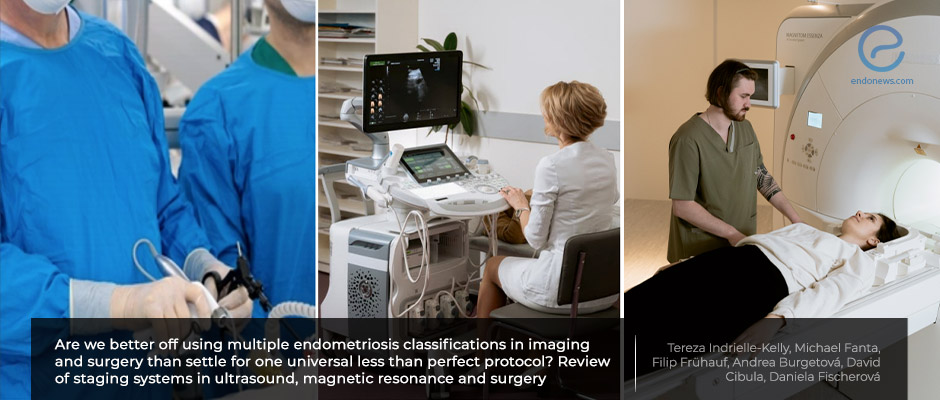Analyses of the main classification systems of endometriosis in terms of utrasound, MRI and surgery
Aug 5, 2021
A standardized description and measurement of endometriosis will help to find a universal classification.
Key Points
Highlights:
- While some classifications are useful for imaging, they are not satisfactory to describe the clinical staging and disease progression.
- To facilitate an international consensus, the image readers and the surgeons should get together, argue, and deal with a universal classification system including standardized measurements.
Importance:
- Attempts of scientific societies for a universal consensus are needed for a reliable classification that will cover nomenclature-extent description, ultrasound, MRI, surgical stagings, risk, and recurrence.
What's done here:
- A review that analyzed all current endometriosis classifications and main evaluation systems, with an aim to raise awareness for establishing a unique and reliable system.
Key points:
- The pathogenesis, causes, and the spreading path of endometriosis are still unclear: This is the first obstacle to produce a realistic and useful classification system.
- All current classifications have their strengths and deficiencies. Surgical stagings reveal anatomic spread anddescription but do not answer the fertility rate, pelvic pain degree, and quality of life.
- Imaging methods such as ultrasound and MRI have their own classifications and they are not even united in a basic descriptive level.
- The extent of the disease is poorly correlated with the type and the severity of symptoms, and the response to medical or surgical treatment are variable.
- The spread of the disease is not uniform, further causing classification difficulties.
- Developing a standard and universal classification for endometriosis needs to declare all extensions, progressions, and outcome.
Lay Summary
Several classifications made by gynecologists, image readers, and radiologists lead to confusion while describing the situation and estimating the progress of endometriosis.
Daniela Fischerova team from the Charles University of Prague, Czech Republic, analyzed the main classifications of endometriosis in three areas, namely ultrasound imaging, MRI, and surgery. While the papers in the current literature compare the classifications only in surgical aspect, the authors intend to call attention to all image readers and gynecologists to come together for a standardized universal and useful terminology and classification.
The main current classification systems are separate for ultrasound, MRI, and several different ones for surgery. Ultrasound Based Endometriosis Staging System "UBESS" was published in 2016, and it facilitates surgical approaches especially in advanced stage endometriosis. Another is "IDEA" established by the International Deep Endometriosis Analyses group helps to minimize the risk of missing lesions in the pelvis. European Society of Urogenital Radiology (ESUR) published some guidelines focusing on technical parameters for MRI classification in 2017. This is a limited protocol for the evaluation of pelvic disease and kidneys.
Several endometriosis classifications for surgery currently in use are ASRM, rASRM, Enzian classification, EEC, EFI. The first surgical classification of endometriosis was published by the American Society of Reproductive Medicine in 1979 and updated as rASRM in 1985, then in 1997. The main advantage of this oldest and simple system is its comprehensive nature for clinicians and the patients. But the staging is not compatible with the severity of pain, infertility, and level of surgery. Endoscopic endometriosis classification was proposed in 1984 resembling rASRM staging except for the details on the extrapelvic invasion of the disease.
Another surgical classification is Enzian classification, described by Kekstein et al. in 2003 in a local meeting and was updated in 2012. This classification divides the pelvis into three compartments with the cervix in the center, and resembles the cervical cancer classification. Enzian classification is mainly being used in German-speaking countries, and it is not sufficient to clarify fertility outcomes, quality of life, and pain symptoms, like rASRM.
Endometriosis Fertility Index (EFI) is useful for its predictive nature of future pregnancy in patients with endometriosis. Despite its value for guiding the patient through options of assisted reproduction, it has shortcomings in pelvic staging.
After analyzing and comparing these classifications the authors suggested "establishing a standardized description and measurement of the disease extent" as the main priority of gynecologists. This guiding paper was published in the "Journal of Obstetrics and Gynecology".
Research Source: https://pubmed.ncbi.nlm.nih.gov/34009105/
Staging ultrasound magnetic resonance laparoscopic surgery endometriosis classification outcome prognosis ARSM

